Stat: Difference between revisions
m (→Speed: ♥♥♥♥♥) |
|||
| Line 71: | Line 71: | ||
====Speed==== | ====Speed==== | ||
The '''Speed stat''' (Japanese: '''{{j|{{tt|素早さ能力|すばやさのうりょく}}}}''' ''speed ability'') determines | The '''Speed stat''' (Japanese: '''{{j|{{tt|素早さ能力|すばやさのうりょく}}}}''' ''speed ability'') determines the order of Pokémon that can act in battle. Pokémon with higher Speed at the start of any turn will generally make a [[move]] before ones with lower Speed; in the case that two Pokémon have the same Speed, one of them will randomly go first. | ||
===In-battle stats=== | ===In-battle stats=== | ||
Revision as of 19:37, 1 January 2017
- HP and Hit Points redirect here. For the move commonly referred to in competitive battling as "HP", see Hidden Power. For the Pokémon Trading Card Game set commonly abbreviated as "HP," see EX Holon Phantoms. For HP in the Trading Card Game, see Glossary of terms.
- Special Attack redirects here. For the class of move in Pokémon GO, see Move → In Pokémon GO.
A statistic (Japanese: 能力 ability), or stat for short, is an element which determines certain aspects of battles in the games. Stats may also refer to the numerical values of each field in regards to individual Pokémon.
In English, stats have been also referred to as abilitiesRBY (as seen via NPCs on the fifth floor of the Celadon Dept. Store) and ratingsGSC (as seen in Growth's move description).
List of stats
Permanent stats
Hit Points
The Hit Points (Japanese: ヒットポイント hit points), or HP for short in both Japanese and English, determine how much damage a Pokémon can receive before fainting. It is the most visible of the stats in battle, appearing both graphically (as a bar with a fill colored green, yellow, or red depending on how much HP in percentage is left) and as a current/max amount below the bar.
If a Pokémon has more than half of its HP, its HP bar remains green. If the Pokémon has between one-fifth and half of its HP, the bar will turn yellow (in Generation II, a Pokémon revived to exactly half of their HP will have a green HP bar). If a Pokémon has less than one-fifth of its HP remaining, the bar will turn red and a beeping sound (Generations I-IV), a change of battle music with the beep as a metronome (Generation V), or a series of 4 beeping sounds before fading away (since Generation VI) will notify the player that his or her Pokémon is in danger of fainting. Before Generation VI, this beeping will continue until the Pokémon is switched out to another Pokémon which has at least one-fifth of its HP, has its HP raised to one-fifth or higher by any means, or faints.
In Generation I, the coloring of the HP bar was determined slightly differently. If the bar's fill was 27 pixels or wider (out of a total end-to-end length of 48 pixels), it would be colored green; if it was between 10 and 26 pixels, it would be colored yellow; and if it was less than 10 pixels wide, it would be colored red. This means the HP bar turns yellow noticeably earlier than in the later games, or at about 56% of the Pokémon's maximum HP.
The HP bar also affects the Pokémon's cry. If a Pokémon's HP bar is green, the player will hear the cry of the Pokémon in its normal sounding rate, but if the Pokémon has less than half of its HP remaining or has fainted, its cry will be lowered by a half-step to indicate its weakened state.
In-battle appearance
Attack
The Attack stat (Japanese: 攻撃能力 attack ability) partly determines how much damage a Pokémon deals when using a physical move. For more information on how Attack affects damage, see Damage formula.
Defense
The Defense stat (Japanese: 防御能力 defense ability) partly determines how much damage a Pokémon receives when it is hit with a physical move. For more information on how Defense affects damage, see Damage formula.
Special
The Special stat (Japanese: とくしゅのうりょく special ability) is an obsolete stat that existed only in Generation I and partially in Generation II.
The Special stat accounted for what is currently known as Special Attack and Special Defense, determining how much damage a Pokémon both receives and deals when special moves are used. This created some balance issues, since a Pokémon could not be made strong with Special attacks but weak against them, or vice versa, the same way a Pokémon might have strong Attack but weak Defense. With Generation II, the Special stat was outwardly split into Special Attack and Special Defense, meaning Pokémon could have different base stat values for both, and those stats were both displayed on a Pokémon's stat screen; however, individual values and effort values remained unsplit, so that there was only a Special individual value and Special effort values, which affected both the Special Attack and Special Defense stats. In Generation III, IVs and EVs were finally given both Special Attack and Special Defense values as well.
Special Attack
The Special Attack stat (Japanese: 特攻能力 special attack ability), or Sp. Atk and Spcl. AtkGSCStad2 for short, partly determines how much damage a Pokémon deals when using a special move. For more information on how Special Attack affects damage, see Damage formula.
Special Defense
The Special Defense stat (Japanese: 特防能力 special defense ability), or Sp. Def and Spcl. DefGSCStad2 for short, partly determines how much damage a Pokémon receives when it is hit with a special move. For more information on how Special Defense affects damage, see Damage formula.
Speed
The Speed stat (Japanese: 素早さ能力 speed ability) determines the order of Pokémon that can act in battle. Pokémon with higher Speed at the start of any turn will generally make a move before ones with lower Speed; in the case that two Pokémon have the same Speed, one of them will randomly go first.
In-battle stats
Evasion
The evasion rate (Japanese: 回避率 evasion rate), or evasiveness, of a Pokémon's move determines its probability of missing the target. The initial value at the start of any battle is 100%. If the evasiveness is decreased below 100% with a move such as Sweet Scent, then the opposing Pokémon has a better chance of its move hitting the opponent. If the evasiveness is increased above 100% with a move such as Double Team, the opposing Pokémon will have a harder time connecting its moves.
Accuracy
The accuracy rate (Japanese: 命中率 accuracy rate) of a Pokémon's move determines its probability of hitting the opponent. The initial value at the start of any battle is 100%. Along with accuracy-raising moves, in Pokémon XD the player can also raise a Pokémon's accuracy by using the call action.
Formula for accuracy and evasion
The probability that a move will hit is calculated as follows:
Where:
- Abase is the base accuracy of the move (in percent - e.g. a base accuracy of 95 is counted as 0.95),
- Accuracy is the current accuracy stat of the user (in percent - e.g. raising accuracy by three stages raises this number to 2), and
- Evasion is the current evasion stat of the target (in percent - e.g. lowering evasion by two stages lowers this number to 0.6).
If P is greater than 1, the move will surely hit. In a Double or Triple Battle, it is possible for a move that hits two or three targets to miss some of the targets and hit others - the probabilities are calculated individually for each target.
Determination of stats
Base stat values
A Pokémon's base stat values will most often have the greatest influence over their specific stats at any level. Disregarding individual values, effort values, and Nature, a level 100 Pokémon's stats in Attack, Defense, Speed, Special Attack, and Special Defense will be exactly 5 more than double its base stat values in each, while the HP stat will be 110 plus double the base stat value (except in the case of Shedinja, whose HP is always 1).
For a list of Pokémon by their base stat values, see the list of Pokémon by base stats.
Level
- Main article: Level
When a Pokémon grows a level, its stats will increase. For each level gained (ignoring Nature), stats will increase by 1/50 the base stat value, and 1/100 the combined individual value and effort value. This means that it is impossible, through leveling up, for a Pokémon to ever lose points in a stat unless it evolves into a Pokémon with a lower base stat value for that specific stat or an EV-reducing Berry is used. It is also impossible for any Pokémon other than Shedinja not to gain HP upon leveling up without using a Pomeg Berry (Pokémon Emerald onward) as no evolutionary line has members with a lower base HP than the pre-evolved forms.
Nature
- Main article: Nature
Most Natures enhance the growth of one stat, while hindering the growth of another. After all other calculations are finished, the stat that the Nature enhances will be 110% of what it would be without the Nature, and the stat hindered will be 90% of its normal value.
Individual values
- Main article: Individual values
Individual values cause two Pokémon of the same species to have different stats. Between generations there are different manners of determining them.
Effort values
- Main article: Effort values
Effort values are what cause a trained Pokémon to have higher stats than an untrained counterpart of the same level. For every 4 EVs gained, a level 100 Pokémon will have 1 extra point in its stats. Variance of stats caused by EVs reaches a maximum of 63 points at level 100, as a Pokémon can gain a maximum of 255 EVs in a single stat.
Formula
- See also: Damage calculation
In Generations I and II
The stat is rounded down if the result is a decimal. Note that the numerator is multiplied by two compared to this formula before rounding. For example, the quantity (base + IV + sqrt(EV)/8) for stats other than HP is rounded down to the nearest integer before multiplying by level and dividing by 50.
Example
Consider a Level 81 Pikachu with the following IVs and EVs:
| HP | Attack | Defense | Sp.Atk | Sp.Def | Speed | Total | |
|---|---|---|---|---|---|---|---|
| Base stat | 35 | 55 | 30 | 50 | 40[1] | 90 | 300 |
| IV | 7[2] | 8 | 13 | 9[3] | 5 | 42 | |
| EV | 22850 | 23140 | 17280 | 19625 | 24795 | 107690 | |
Its HP can be calculated as follows:
File:StatExampleHPGen2.png File:StatExampleHPGen2 2.png
Its Special Attack and Special Defense stats simply rely on the Special EV and IV.
File:StatExampleSpAtkGen2 1.png File:StatExampleSpAtkGen2 2.png
File:StatExampleSpDefGen2 1.png File:StatExampleSpDefGen2 2.png
Its Speed can be calculated as follows:
File:StatExampleSpeedGen2 1.png File:StatExampleSpeedGen2 2.png
In the end, this Pikachu's stats are:
| HP | Attack | Defense | Sp.Atk | Sp.Def | Speed | |
|---|---|---|---|---|---|---|
| Base stat | 35 | 55 | 30 | 50 | 40 | 90 |
| IV | 7 | 8 | 13 | 9 | 5 | |
| EV | 22850 | 23140 | 17280 | 19625 | 24795 | |
| Total | 189 | 137 | 101 | 128 | 112 | 190 |
Note that some numbers may be off by one due to rounding.
In Generation III onward
The stat is rounded down if the result is a decimal. The stat is also rounded down before the Nature multiplier, if any, is applied.
These formulas mean that, aside from Shedinja's HP (which is always 1) the lowest a stat can ever possibly be is 4 (or, for the HP stat, 11).
Example
Consider a Level 78 Garchomp with the following IVs and EVs and an Adamant nature:
| HP | Attack | Defense | Sp.Atk | Sp.Def | Speed | Total | |
|---|---|---|---|---|---|---|---|
| Base stat | 108 | 130 | 95 | 80 | 85 | 102 | 600 |
| IV | 24 | 12 | 30 | 16 | 23 | 5 | 110 |
| EV | 74 | 195 | 86 | 48 | 84 | 23 | 510 |
Its HP can be calculated as follows:
File:StatExampleHPGen4.png File:StatExampleHPGen4 2.png
The Adamant nature raises Attack and lowers Special Attack. This means that when calculating the Attack stat, Nature = 1.1, and when calculating the Special Attack stat, Nature = 0.9. So this Garchomp's Attack stat will be:
File:StatExampleAttackGen4 1.png File:StatExampleAttackGen4 2.png
And its Special Attack stat will be:
File:StatExampleSpAtkGen4 1.png File:StatExampleSpAtkGen4 2.png
Its Speed stat, on the other hand, has no Nature multiplier, so it is calculated as:
File:StatExampleSpeedGen4 1.png File:StatExampleSpeedGen4 2.png
In the end, this Garchomp's stats are as follows:
| HP | Attack | Defense | Sp.Atk | Sp.Def | Speed | |
|---|---|---|---|---|---|---|
| Base stat | 108 | 130 | 95 | 80 | 85 | 102 |
| IV | 24 | 12 | 30 | 16 | 23 | 5 |
| EV | 74 | 195 | 86 | 48 | 84 | 23 |
| Total | 289 | 280 | 193 | 136 | 171 | 172 |
Note that some numbers may be off by one due to rounding.
Stat modifiers
When a stat is used in a calculation in battle, a number of modifiers may be applied during the calculation. During a battle, a Pokémon's effective stats may be raised or lowered by certain moves, Abilities, and held items. Some attacks may only have a chance of raising or lowering stats, while certain Abilities and held items may require a triggering event to activate any stat modifications.
The modifiers conferred by moves operate on a sliding scale of stages. When a given stat is raised or lowered, its current stage is increased or decreased by the amount dictated by the move, up to a maximum of +6 or a minimum of -6. A given stage corresponds to a given multiplier that will modify the stat when it is used in battle calculations. The exact multipliers for stages are detailed in a later section below. Note that prior to Generation III, no stat can fall below 1 or rise above 999; any further modifiers will fail regardless of whether the stat is at -6 or +6 or not.
While some Abilities and held items may also modify the stages of a Pokémon's stats, others may apply unique multipliers that are separate from—and thus can stack with—stages. Examples include the Ability Slow Start, which temporarily halves Attack and Speed, and the held item Choice Band, which boosts Attack by 50%.
A few items may also modify a Pokémon's stats outside of battle by increasing or decreasing the effort values (EVs) for that stat. Vitamins and wings increase EVs, while "EV Berries" (No. 21, Pomeg, to No. 26, Tamato) reduce EVs.
In-battle modification
In the table below, anything in italics is capable of modifying one stat out of two or more and may not always affect the same one.
Out-of-battle modification
| Stat | Raisers | Reducers | |
|---|---|---|---|
| Attack | Protein | Muscle Wing | Kelpsy Berry |
| Defense | Iron | Resist Wing | Qualot Berry |
| Special Attack | Calcium | Genius Wing | Hondew Berry |
| Special Defense | Zinc | Clever Wing | Grepa Berry |
| Speed | Carbos | Swift Wing | Tamato Berry |
Stage modification quotes
The "Pokémon" identifier in the quotes below includes a prefix that varies depending on the situation; most wild Pokémon (but not all) and opposing Pokémon have one.
| Change | Generation I | Generation II | Generation III | Generation IV | Generation V | Generation VI | Generation VII | |
|---|---|---|---|---|---|---|---|---|
| too high | Nothing happened! | <Pokémon>'s <stat> won't rise anymore! | <Pokémon>'s <stat> won't go higher! | <Pokémon>'s <stat> won't go any higher! | ||||
| +1 | <Pokémon>'s <stat> rose! | <Pokémon>'s <stat> went up! | <Pokémon>'s <stat> rose! | |||||
| +2 | <Pokémon>'s <stat> greatly rose! | <Pokémon>'s <stat> went way up! | <Pokémon>'s <stat> sharply rose! | <Pokémon>'s <stat> rose sharply! | ||||
| +3 or higher | <Pokémon>'s <stat> rose drastically! | |||||||
| too low | Nothing happened! | <Pokémon>'s <stat> won't drop anymore! | <Pokémon>'s <stat> won't go lower! | <Pokémon>'s <stat> won't go any lower! | ||||
| -1 | <Pokémon>'s <stat> fell! | |||||||
| -2 | <Pokémon>'s <stat> greatly fell! | <Pokémon>'s <stat> sharply fell! | <Pokémon>'s <stat> harshly fell! | |||||
| -3 or lower | <Pokémon>'s <stat> severely fell! | |||||||
Stage multipliers
When a move is used that increases or decreases a stat of a Pokémon in battle, it will be multiplied according to the following fractions, depending on the generation:
- For Attack, Defense, Sp. Attack, Sp. Defense, and Speed
| Stage | -6 | -5 | -4 | -3 | -2 | -1 | 0 | +1 | +2 | +3 | +4 | +5 | +6 |
|---|---|---|---|---|---|---|---|---|---|---|---|---|---|
| Gen I-II | 25/100 | 28/100 | 33/100 | 40/100 | 50/100 | 66/100 | 100/100 | 150/100 | 200/100 | 250/100 | 300/100 | 350/100 | 400/100 |
| Gen III+ | 2/8 | 2/7 | 2/6 | 2/5 | 2/4 | 2/3 | 2/2 | 3/2 | 4/2 | 5/2 | 6/2 | 7/2 | 8/2 |
- For accuracy and evasion
| Stage (accuracy) | -6 | -5 | -4 | -3 | -2 | -1 | 0 | +1 | +2 | +3 | +4 | +5 | +6 |
|---|---|---|---|---|---|---|---|---|---|---|---|---|---|
| Stage (evasion) | +6 | +5 | +4 | +3 | +2 | +1 | 0 | -1 | -2 | -3 | -4 | -5 | -6 |
| Gen I | 25/100 | 28/100 | 33/100 | 40/100 | 50/100 | 66/100 | 100/100 | 150/100 | 200/100 | 250/100 | 300/100 | 350/100 | 400/100 |
| Gen II | 33/100 | 36/100 | 43/100 | 50/100 | 60/100 | 75/100 | 100/100 | 133/100 | 166/100 | 200/100 | 233/100 | 266/100 | 300/100 |
| Gen III-IV | 33/100 | 36/100 | 43/100 | 50/100 | 60/100 | 75/100 | 100/100 | 133/100 | 166/100 | 200/100 | 250/100 | 266/100 | 300/100 |
| Gen V+ | 3/9 | 3/8 | 3/7 | 3/6 | 3/5 | 3/4 | 3/3 | 4/3 | 5/3 | 6/3 | 7/3 | 8/3 | 9/3 |
In Generations I and II, accuracy and evasion stages are resolved separately and both multipliers applied to the move's accuracy to determine the final chance of a move hitting or missing. For example, a Pokémon with -1 accuracy using a move that has 100% accuracy on a target with +1 evasion would have a 66/100 * 66/100 ~= 43.56% chance of hitting in Generation I, or a 75/100 * 75/100 ~= 56.25% chance of hitting in Generation II. In Generation III, this was changed so that the stages of the two stats are now combined before determining the multiplier, with the evasion stage subtracted from the accuracy stage. Therefore, in the above situation, the attacking Pokémon would have a 60/100 = 60% chance of hitting.[1]
Additionally, the combined stages are capped at -6 and +6 from Generation III onward, meaning that a Pokémon with minimum accuracy attacking a target with maximum evasion will have no lower than a 33/100 or 33% chance to hit. (For comparison, in Generation II, the attacker would only have a 33/100 * 33/100 ~= 10.89% chance of hitting.)
In other games
In the Mystery Dungeon series
In the Pokémon Mystery Dungeon series, Pokémon have HP, Attack, Defense, Special Attack, and Special Defense and SpeedSMD, stats just like in the core games. However, these games also have a few stats not seen in the core games.
Movement speed
- Main article: Movement speed
Movement speed is roughly considered the Mystery Dungeon series' analogue to Speed in the core games. Movement speed governs the number of actions (such as moving, attacking, or using an item) a Pokémon may take in a given turn.
Speed
The Speed stat was not used in the Pokémon Mystery Dungeon series until Super Mystery Dungeon where it is used as an accuracy modifier; the higher speed a Pokémon has, the more likely it is for its moves to hit and the more likely it is to evade attacks.
Belly
The Belly (Japanese: おなか stomach) is a hunger statistic in the Pokémon Mystery Dungeon series. As the team leader explores a dungeon, its Belly will diminish as turns go by, represented by a number decreasing from 100. Holding certain scarves will cause the Belly to decrease more quickly. Walking one step takes 1/10RBTDSGtI1/7SMD belly point, pushing other Pokémon takes a half belly point and performing aliances three. Other items will cause the Belly to deplete at a much slower rate, or not deplete at all. While a Pokémon's Belly is empty, it will no longer be able to run or perform aliances and its HP will decrease by 1RBTDSGtI/3SMD with every step it takes until it either faints or eats something.
In Gates to Infinity, this feature was removed for most dungeons, but the mechanic returned in all dungeons in Super Mystery Dungeon.
Belly can be replenished by eating most consumable items. When something is eaten at maximum Belly, the Pokémon's maximum Belly will increase temporarily until the dungeon is exited.
Stat modifiers
Stat modification works basically the same in the Pokémon Mystery Dungeon series as in the core series, but stat stages can range from -10 to +10. Whenever a Pokémon leaves a dungeon, advances a floor, or steps on a Wonder Tile, its stat stages reset to 0.[2]
Stage multipliers
The Pokémon Mystery Dungeon series uses different multipliers for its stat stages than the core series games do.
- For Attack and Sp. Attack
| Subtractive moves | Base | Supplemental moves | ||||||||||||||||||||
|---|---|---|---|---|---|---|---|---|---|---|---|---|---|---|---|---|---|---|---|---|---|---|
| Stage | -10 | -9 | -8 | -7 | -6 | -5 | -4 | -3 | -2 | -1 | 0 | +1 | +2 | +3 | +4 | +5 | +6 | +7 | +8 | +9 | +10 | |
| Multiplier | 128/256 | 133/256 | 138/256 | 143/256 | 148/256 | 153/256 | 161/256 | 171/256 | 179/256 | 204/256 | 1 | 307/256 | 332/256 | 358/256 | 384/256 | 409/256 | 422/256 | 435/256 | 448/256 | 460/256 | 473/256 | |
| Percentage | 50% | 52% | 54% | 56% | 58% | 60% | 63% | 67% | 70% | 80% | 100% | 120% | 130% | 140% | 150% | 160% | 165% | 170% | 175% | 180% | 185% | |
- For Defense and Sp. Defense
| Subtractive moves | Base | Supplemental moves | ||||||||||||||||||||
|---|---|---|---|---|---|---|---|---|---|---|---|---|---|---|---|---|---|---|---|---|---|---|
| Stage | -10 | -9 | -8 | -7 | -6 | -5 | -4 | -3 | -2 | -1 | 0 | +1 | +2 | +3 | +4 | +5 | +6 | +7 | +8 | +9 | +10 | |
| Multiplier | 7/256 | 12/256 | 25/256 | 38/256 | 51/256 | 64/256 | 76/256 | 102/256 | 128/256 | 179/256 | 1 | 332/256 | 409/256 | 486/256 | 537/256 | 588/256 | 640/256 | 691/256 | 742/256 | 793/256 | 844/256 | |
| Percentage | 3% | 5% | 10% | 15% | 20% | 25% | 30% | 40% | 50% | 70% | 100% | 130% | 160% | 190% | 210% | 230% | 250% | 270% | 290% | 310% | 330% | |
- For accuracy
| Subtractive moves | Base | Supplemental moves | ||||||||||||||||||||
|---|---|---|---|---|---|---|---|---|---|---|---|---|---|---|---|---|---|---|---|---|---|---|
| Stage | -10 | -9 | -8 | -7 | -6 | -5 | -4 | -3 | -2 | -1 | 0 | +1 | +2 | +3 | +4 | +5 | +6 | +7 | +8 | +9 | +10 | |
| Multiplier | 84/256 | 89/256 | 94/256 | 102/256 | 110/256 | 115/256 | 140/256 | 153/256 | 179/256 | 204/256 | 1 | 320/256 | 384/256 | 409/256 | 422/256 | 435/256 | 448/256 | 460/256 | 473/256 | 486/256 | 2 | |
| Percentage | 33% | 35% | 37% | 40% | 43% | 45% | 55% | 60% | 70% | 80% | 100% | 125% | 150% | 160% | 165% | 170% | 175% | 180% | 185% | 190% | 200% | |
- For evasion
| Subtractive moves | Base | Supplemental moves | ||||||||||||||||||||
|---|---|---|---|---|---|---|---|---|---|---|---|---|---|---|---|---|---|---|---|---|---|---|
| Stage | -10 | -9 | -8 | -7 | -6 | -5 | -4 | -3 | -2 | -1 | 0 | +1 | +2 | +3 | +4 | +5 | +6 | +7 | +8 | +9 | +10 | |
| Multiplier | 2 | 486/256 | 473/256 | 460/256 | 448/256 | 435/256 | 422/256 | 409/256 | 384/256 | 345/256 | 263/256 | 204/256 | 179/256 | 153/256 | 128/256 | 102/256 | 89/256 | 76/256 | 64/256 | 51/256 | 38/256 | |
| Percentage | 200% | 190% | 185% | 180% | 175% | 170% | 165% | 160% | 150% | 135% | 103% | 80% | 70% | 60% | 50% | 40% | 35% | 30% | 25% | 20% | 15% | |
In Pokémon Conquest

|
This section is incomplete. Please feel free to edit this section to add missing information and complete it. Reason: Formulas for determining stats |
In Pokémon Conquest, Pokémon have HP, Range, Attack, Defense, and Speed stats, as well as a non-numeric Energy stat, and a derived stat called Strength.
While Range remains a fixed value, HP, Attack, Defense, and Speed are influenced by the Pokémon's Energy, and will also increase when the link with their Warrior increases. Also, since a Warrior's stats influence the Pokémon's Attack, Defense, and Speed, ranking up a Warlord will raise their Warrior stats along with their Pokémon's stats.
Range
Range (Japanese: いどう movement) determines the amount of tiles a Pokémon is able to move across the game's grid-based battlefields. This stat is a species-specific value; each of the 200 Pokémon species found in the game has a natural Range of 2, 3, or 4, with 3 being the most common. This means that any two Pokémon of the same species will always have the same Range unless something has modified their Ranges (signified by the value's text color changing from black to blue).
Range can be temporarily modified during battle by various Warrior Skills, Abilities, and moves. The Ability Sprint permanently modifies Range, keeping it 1 above its natural value even outside of battle. Range has a maximum value of 6 and a minimum of 1. Snowy terrain will also hinder a Pokémon's movement.
Speed
In Pokémon Conquest, Speed does not determine movement or who gets to move first. Rather, Speed acts as a combination of Accuracy and Evasion. One Pokémon attacking another Pokémon that is significantly faster than it will have a lesser chance to hit its opponent, while a Pokémon that is faster than its opponent will have a better chance to hit it.
Energy
Energy (Japanese: テンション Tension) affects a Pokémon's performance in battle and their link with their Warrior. A Pokémon's Energy can fluctuate between 5 levels, indicated by an arrow icon next to the Pokémon. A neutral state is indicated by a yellow arrow pointing straight right, while a higher state is indicated by the arrow angling upwards and turning more orange and a lower state is indicated by the arrow angling downwards and turning blue.
A Pokémon with maximum Energy will have slightly higher stats (except Range) and will gain slightly more link percentage after a battle; a Pokémon with minimum Energy will have slightly lower stats (except Range) and will gain less link percentage. Regardless of its Energy level or how often it is used in battle, a Pokémon's Energy will drop by one level after three months.
The main way to recover Energy is by visiting Ponigiri Shops, where buying Ponigiri will recover Energy for all Pokémon visiting the shop. Upgrading a Ponigiri shop allows for more expensive Ponigiri to be purchased which recover more Energy at once. Sometimes, the shop owner will offer a free second helping; accepting will either raise the Pokémon's Energy to a maximum, or cause it to drop. Energy can also be increased with certain kingdom events. Energy can also be recovered during battle by using items, or by using certain Warrior Skills. However, Energy boosts granted by a Warrior Skill only last the duration of the current battle, and the Pokémon's Energy will return to its pre-battle value afterward.
Strength
Strength (Japanese: せんりょく battle ability) is a derived value of the overall power of the Pokémon written as a number displayed next to the Pokémon. It increases when a Pokémon's link with its Warrior increases. It is also influenced by the Pokémon's Energy. A Warrior's army has a Strength equal to the combined Strength of their Pokémon. The strength of a Warrior's army may influence the behavior of other Warriors and the Strength of their armies.
Warrior stats
- Main article: Warrior → Stats
A Warrior in Pokémon Conquest has four stats of their own as well: Power, Wisdom, Charisma, and Capacity. Power, Wisdom, and Charisma influence how well the Pokémon a Warrior is linked with perform in battle, as well as the outcomes when the Warrior visits various kingdom locations. Capacity limits the number of Pokémon a Warrior can link with.
In Pokémon GO

|
This section is incomplete. Please feel free to edit this section to add missing information and complete it. Reason: Stat calculation example |
Pokémon in Pokémon GO have HP, Attack, and Defense stats, similarly to the core games, as well as a derived stat, CP. Pokémon GO makes no distinction between physical or special damage like the core games do, so instead, all attacks simply use Attack and Defense to calculate damage. Of the four stats in Pokémon GO, however, only HP and CP are directly visible.
CP
CP, or Combat Power (Japanese: 総合的な強さ Total Power) is a stat that roughly indicates a Pokémon's capability in combat. CP's value is derived from all three of the other stats, with Attack most heavily influencing its value. This means that two Pokémon of the same species with the same CP may still have slightly different underlying stats.
Determination of stats
Calculating stats in Pokémon GO depends fairly simply on a Pokémon's base stats, IVs, and Power Up level. Whereas the core games have many ways in which one Pokémon's stats can become different from another's, in Pokémon GO, ultimately only a Pokémon's IVs will distinguish its stats from another of the same species.
The formulas for the three basic stats are...
...where base and IV refer to the relevant base stat (HP is calculated using the base Stamina) and IV for the stat in question, and lvMult is a multiplier determined by the Pokémon's current Power Up level. However, the minimum value for HP is 10. Pokémon defending a Gym have twice their regular HP during battles.
The formula for CP uses the values of the stats resulting from the formula above (without rounding their results and before accounting for HP's minimum of 10):
However, like HP, the minimum value for CP is also 10. Since Attack is factored directly into the formula for CP while HP and Defense are only factored in after taking their square root, this gives Attack a greater influence on the final value of CP than the other two stats.
In the anime
Stats in the anime appear to leave out the Special and Physical concept. It is more dependent on attack power and the amount of damage inflicted instead of Attack and Special Attack, and endurance rather than Special Defense and Defense. One example was seen in Pedal to the Mettle! when Paul's Weavile used Swords Dance, an Attack-boosting move, which boosted Blizzard, a special move, as well as Ice Shard and Metal Claw. Another instance was in Shocks and Bonds, where Johnny's Aggron's Harden, a Defense-boosting move, appeared to defend against Tyson's Sceptile's Solar Beam, a special move.
As of the XY series, Pokémon will occasionally glow red after their attack strength has changed, as exhibited by Korrina's Lucario in Mega Revelations!, or blue after their defensive strength has been changed, as shown by Alain's Mega Charizard X in Mega Evolution Special II, Ramos's Jumpluff in The Green, Green Grass Types of Home!, and Ash's Pikachu in A Riveting Rivalry!.
Gallery

|
This section is incomplete. Please feel free to edit this section to add missing information and complete it. Reason: Generation VI, VII, XD, Colo |

|

|
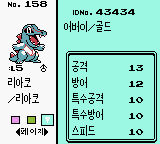
|
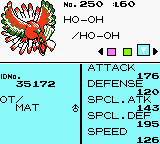
|
| Generation I | Generation II (Japanese) | Generation II (Korean) | Generation II (International) |
|---|---|---|---|
| File:RSE status screen.png | 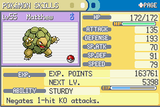
|
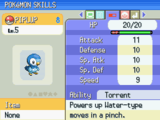
| |
| RSE | FRLG | DPPt | |
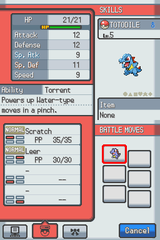
|
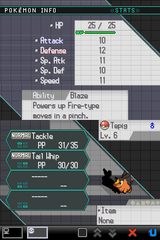
| ||
| HGSS | Generation V |
In other languages
Stat
| |||||||||||||||||||||||||||||||||||
|
Hit Points
|
Attack
|
Defense
| ||||||||||||||||||||||||||||||||||||||||||||||||||||||||||||||||||||||||||||||||||||||||||||||||||||||||||||||||||||||||||||||||||||||||||||||||||||||||||||||||||||||||||||||||||||||||
|
Special Attack
|
Special Defense
|
Speed
| ||||||||||||||||||||||||||||||||||||||||||||||||||||||||||||||||||||||||||||||||||||||||||||||||||||||||||||||||||||||||||||||||||||||||||||||||||||||||||||||||||||||||||||||||||||||||
|
Special
|
Accuracy
|
Evasiveness
| ||||||||||||||||||||||||||||||||||||||||||||||||||||||||||||||||||||||||||||||||||||||||||||||||||||||||||||||||||||||||||||||||||||||||||||||||||||||||||||||||||||||||||||||||||||||||
|
Belly
|
Combat Power
| |||||||||||||||||||||||||||||||||||||||||||||||||||||||||||||||||||||||||||||||||||||||||||||||||||||||||||||||||||||||||||||||||||||||||||||||||||||||||||||||||||||||||||||||||||||||||
See also
- Base stats
- List of Pokémon by base stats (Generation I)
- List of Pokémon by base stats (Generation II-V)
- List of Pokémon by base stats (Generation VI)
- List of Pokémon by base stats (Generation VII-present)
- List of fully evolved Pokémon by base stats
- List of Pokémon with unique base stat totals
Notes
| Pokémon individuality | ||
|---|---|---|
| ||

|
This game mechanic article is part of Project Games, a Bulbapedia project that aims to write comprehensive articles on the Pokémon games. |




